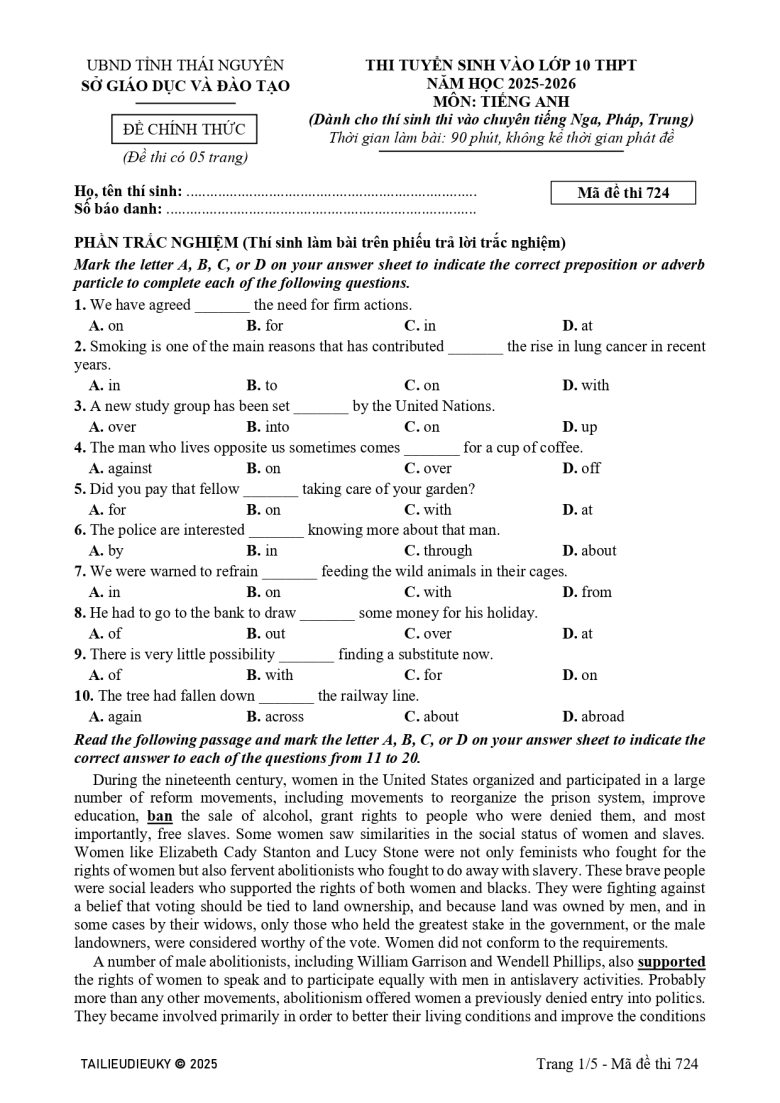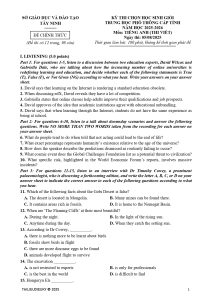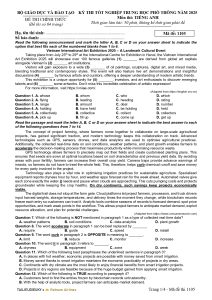Kỳ thi tuyển sinh vào lớp 10 THPT Chuyên Thái Nguyên luôn là một trong những sự kiện giáo dục được quan tâm hàng đầu. Để chuẩn bị cho năm học tới 2025-2026. Mời các thí sinh cùng nhìn lại Đề thi Chuyên Nga, Pháp Trung Thái Nguyên 2025 (chính thức) của Sở GD&ĐT. Dưới đây là phần trắc nghiệm mã đề thi 724 gồm 05 trang và đáp án tham khảo.
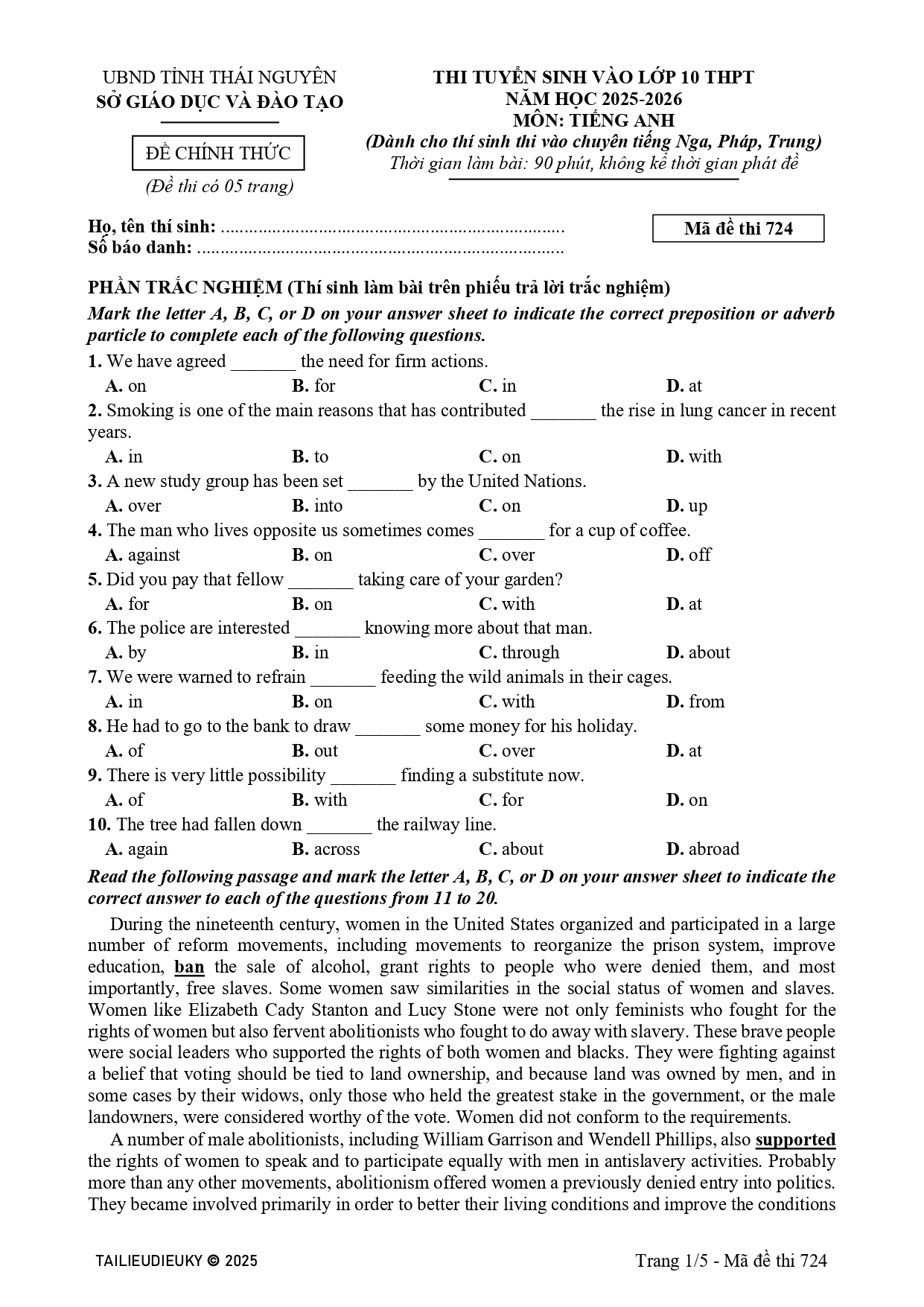
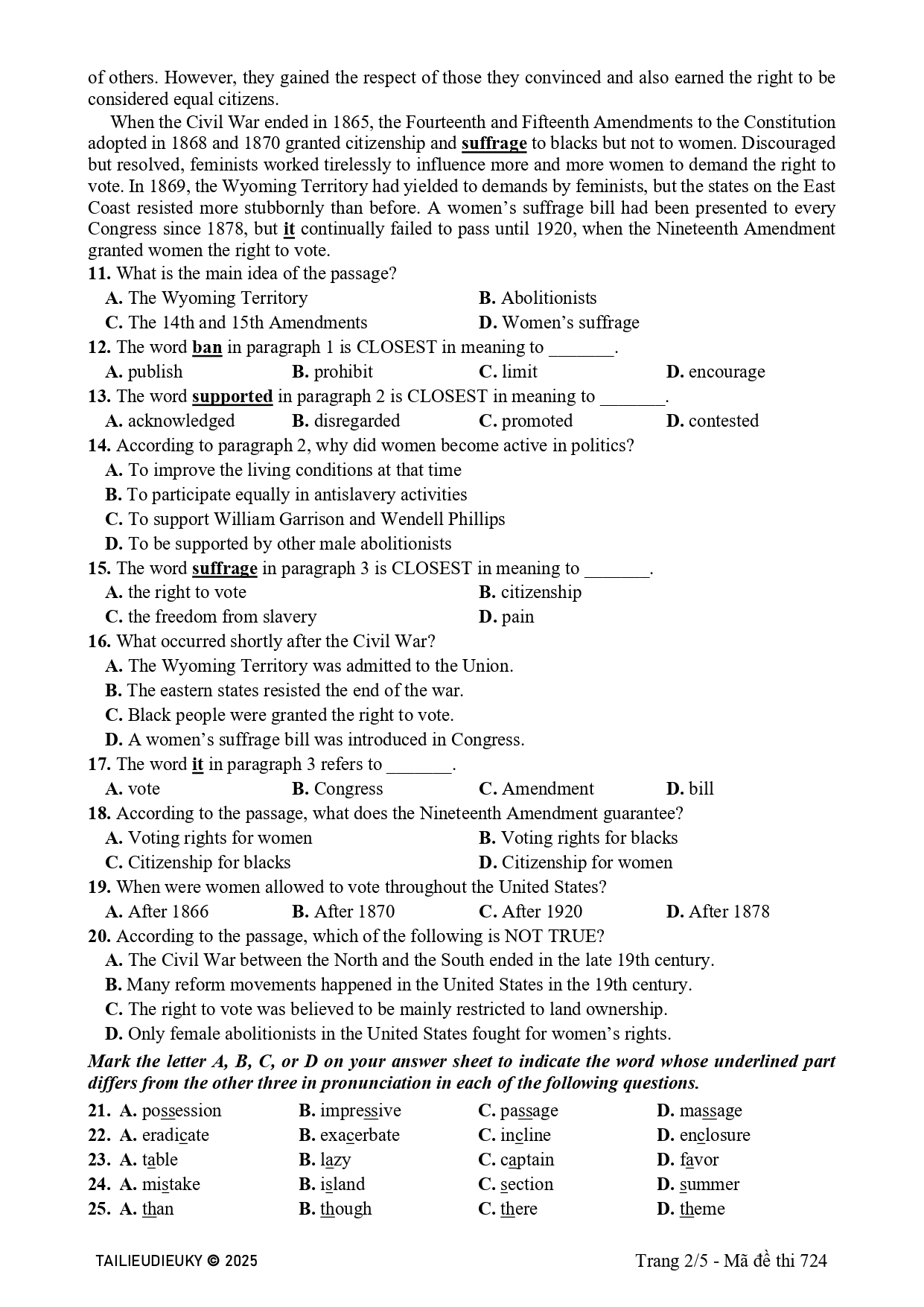
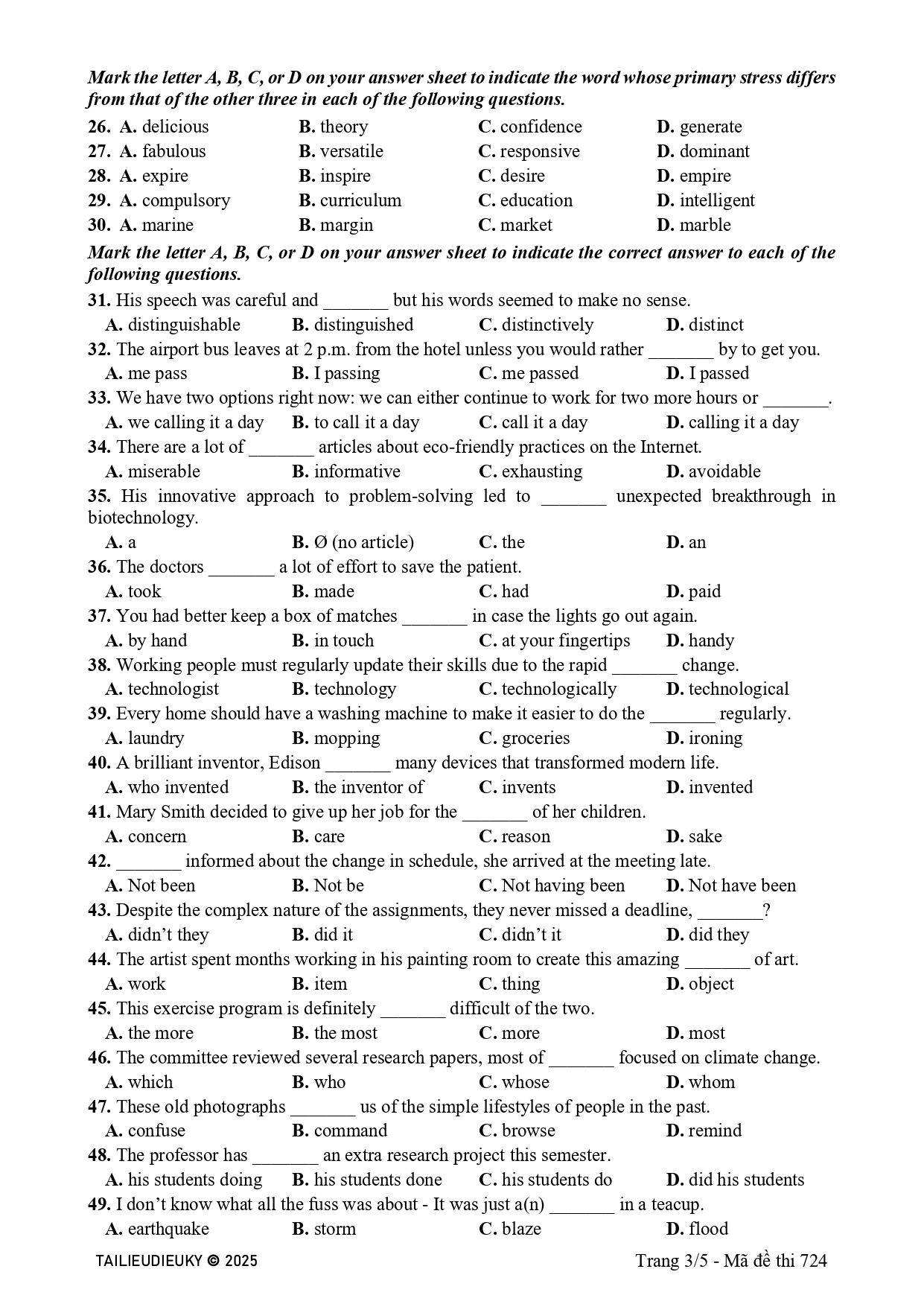
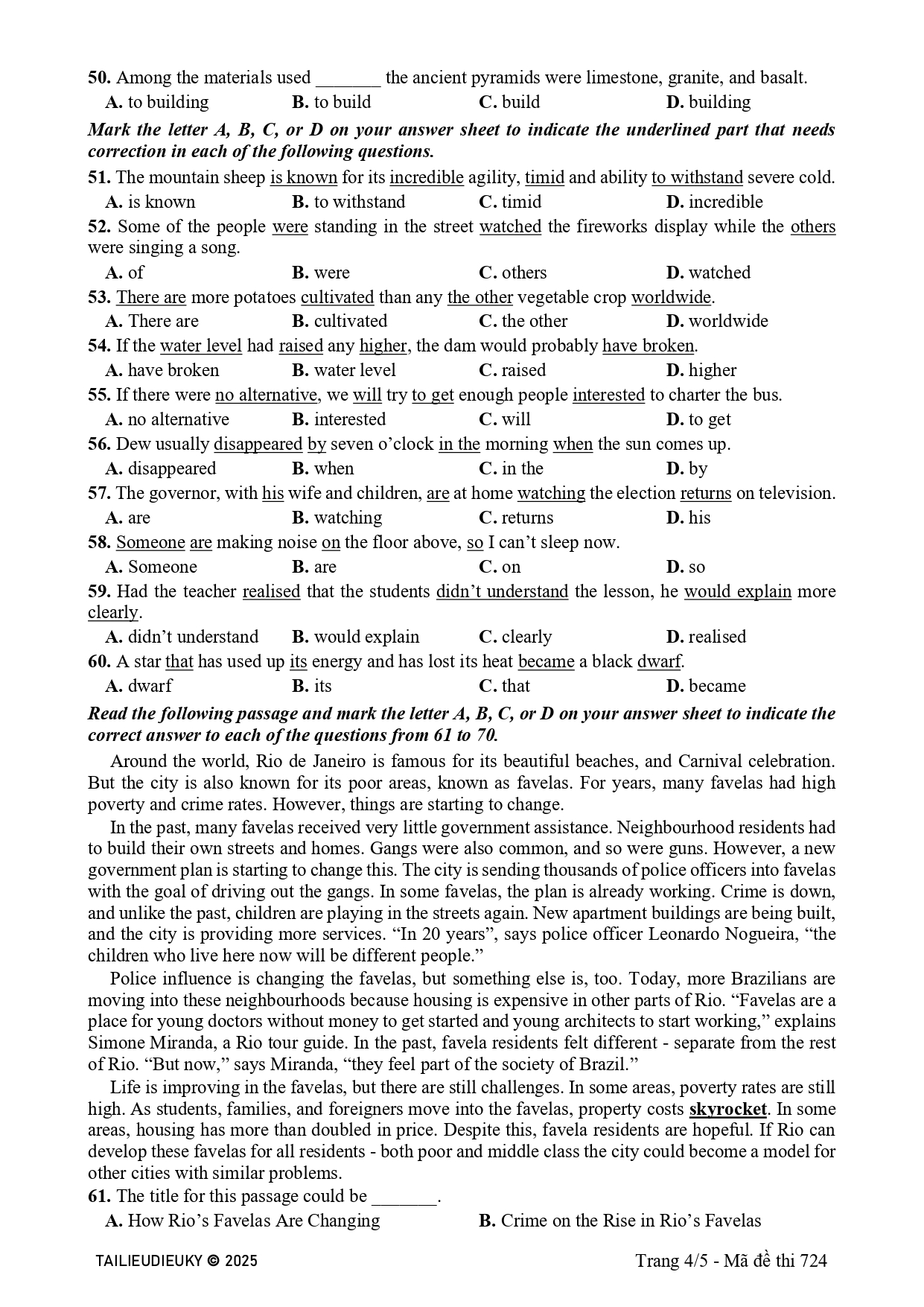
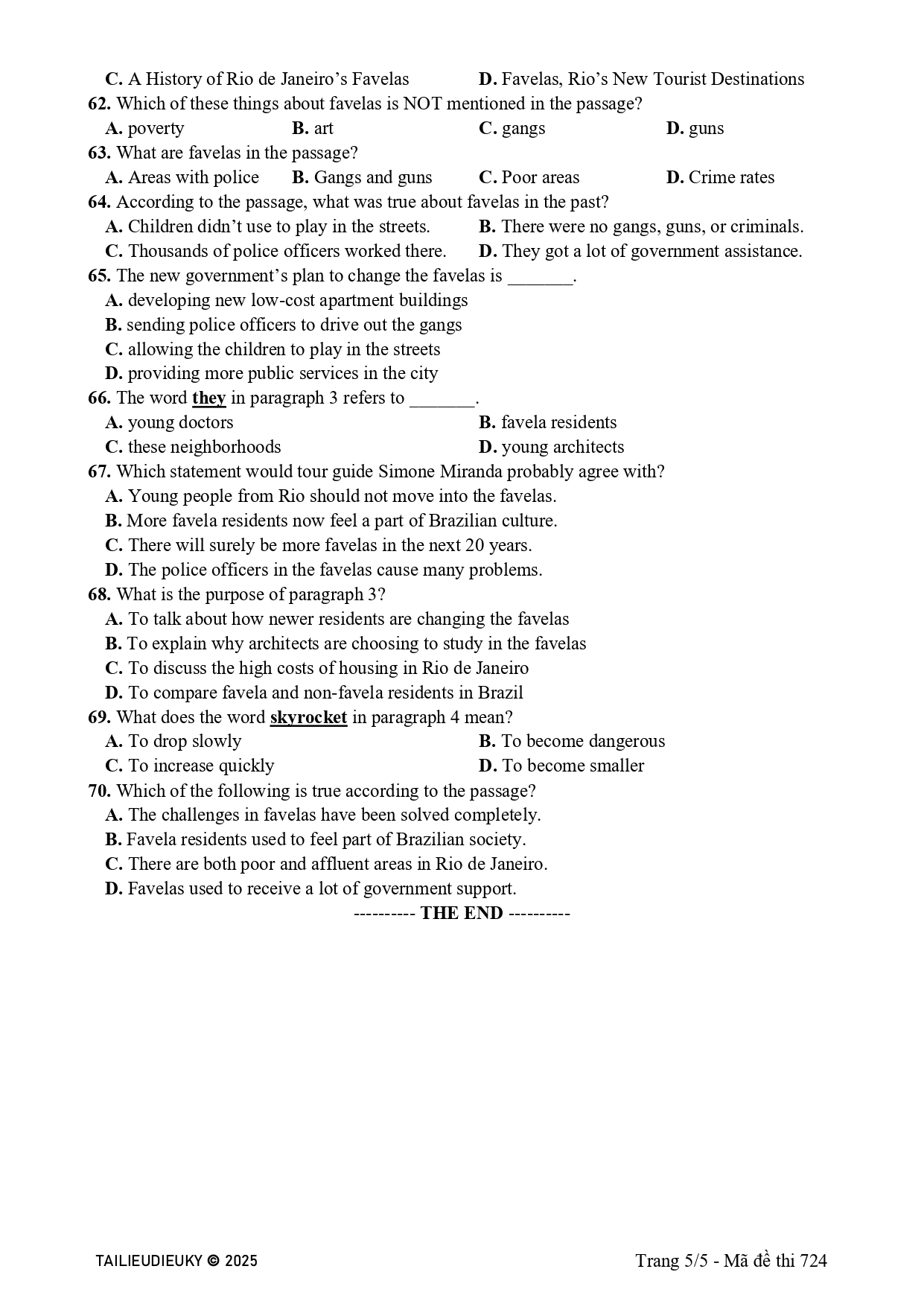
| STT | Phần | Số câu |
|---|---|---|
| 1 | Prepositions & Phrasal verbs | 10 |
| 2 | Reading comprehension (đoạn 1) | 10 |
| 3 | Pronunciation – sounds | 5 |
| 4 | Pronunciation – stress | 5 |
| 5 | Grammar & Vocabulary | 20 |
| 6 | Error identification | 10 |
| 7 | Reading comprehension (đoạn 2) | 10 |
| TỔNG CỘNG | 70 | |
Tải xuống tài liệu
Hy vọng bộ đề thi Chuyên Nga, Pháp, Trung Thái Nguyên 2025 (chính thức) kèm đáp án sẽ giúp các em học sinh hiểu rõ cấu trúc, củng cố kiến thức và có định hướng ôn tập hiệu quả. Bạn có thể tải xuống file PDF đầy đủ ở đường dẫn phía dưới.
>> Tham khảo thêm các tài liệu tương tự TẠI ĐÂY.
Nội dung đề thi
UBND TỈNH THÁI NGUYÊN
SỞ GIÁO DỤC VÀ ĐÀO TẠO
(Đề thi có 05 trang)
THI TUYỂN SINH VÀO LỚP 10 THPT
NĂM HỌC 2025-2026
MÔN: TIẾNG ANH
(Dành cho thí sinh thi vào chuyên tiếng Nga, Pháp, Trung)
Thời gian làm bài: 90 phút, không kể thời gian phát đề
Họ, tên thí sinh: ..........................................................................
Số báo danh: ...............................................................................
PHẦN TRẮC NGHIỆM (Thí sinh làm bài trên phiếu trả lời trắc nghiệm)
Mark the letter A, B, C, or D on your answer sheet to indicate the correct preposition or adverb particle to complete each of the following questions.
1. We have agreed _______ the need for firm actions.
A. on B. for C. in D. at
2. Smoking is one of the main reasons that has contributed _______ the rise in lung cancer in recent years.
A. in B. to C. on D. with
3. A new study group has been set _______ by the United Nations.
A. over B. into C. on D. up
4. The man who lives opposite us sometimes comes _______ for a cup of coffee.
A. against B. on C. over D. off
5. Did you pay that fellow _______ taking care of your garden?
A. for B. on C. with D. at
6. The police are interested _______ knowing more about that man.
A. by B. in C. through D. about
7. We were warned to refrain _______ feeding the wild animals in their cages.
A. in B. on C. with D. from
8. He had to go to the bank to draw _______ some money for his holiday.
A. of B. out C. over D. at
9. There is very little possibility _______ finding a substitute now.
A. of B. with C. for D. on
10. The tree had fallen down _______ the railway line.
A. again B. across C. about D. abroad
Read the following passage and mark the letter A, B, C, or D on your answer sheet to indicate the correct answer to each of the questions from 11 to 20.
During the nineteenth century, women in the United States organized and participated in a large number of reform movements, including movements to reorganize the prison system, improve education, ban the sale of alcohol, grant rights to people who were denied them, and most importantly, free slaves. Some women saw similarities in the social status of women and slaves. Women like Elizabeth Cady Stanton and Lucy Stone were not only feminists who fought for the rights of women but also fervent abolitionists who fought to do away with slavery. These brave people were social leaders who supported the rights of both women and blacks. They were fighting against a belief that voting should be tied to land ownership, and because land was owned by men, and in some cases by their widows, only those who held the greatest stake in the government, or the male landowners, were considered worthy of the vote. Women did not conform to the requirements.
A number of male abolitionists, including William Garrison and Wendell Phillips, also supported the rights of women to speak and to participate equally with men in antislavery activities. Probably more than any other movements, abolitionism offered women a previously denied entry into politics. They became involved primarily in order to better their living conditions and improve the conditions of others. However, they gained the respect of those they convinced and also earned the right to be considered equal citizens.
When the Civil War ended in 1865, the Fourteenth and Fifteenth Amendments to the Constitution adopted in 1868 and 1870 granted citizenship and suffrage to blacks but not to women. Discouraged but resolved, feminists worked tirelessly to influence more and more women to demand the right to vote. In 1869, the Wyoming Territory had yielded to demands by feminists, but the states on the East Coast resisted more stubbornly than before. A women’s suffrage bill had been presented to every Congress since 1878, but it continually failed to pass until 1920, when the Nineteenth Amendment granted women the right to vote.
11. What is the main idea of the passage?
A. The Wyoming Territory B. Abolitionists
C. The 14th and 15th Amendments D. Women’s suffrage
12. The word ban in paragraph 1 is CLOSEST in meaning to _______.
A. publish B. prohibit C. limit D. encourage
13. The word supported in paragraph 2 is CLOSEST in meaning to _______.
A. acknowledged B. disregarded C. promoted D. contested
14. According to paragraph 2, why did women become active in politics?
A. To improve the living conditions at that time
B. To participate equally in antislavery activities
C. To support William Garrison and Wendell Phillips
D. To be supported by other male abolitionists
15. The word suffrage in paragraph 3 is CLOSEST in meaning to _______.
A. the right to vote B. citizenship
C. the freedom from slavery D. pain
16. What occurred shortly after the Civil War?
A. The Wyoming Territory was admitted to the Union.
B. The eastern states resisted the end of the war.
C. Black people were granted the right to vote.
D. A women’s suffrage bill was introduced in Congress.
17. The word it in paragraph 3 refers to _______.
A. vote B. Congress C. Amendment D. bill
18. According to the passage, what does the Nineteenth Amendment guarantee?
A. Voting rights for women B. Voting rights for blacks
C. Citizenship for blacks D. Citizenship for women
19. When were women allowed to vote throughout the United States?
A. After 1866 B. After 1870 C. After 1920 D. After 1878
20. According to the passage, which of the following is NOT TRUE?
A. The Civil War between the North and the South ended in the late 19th century.
B. Many reform movements happened in the United States in the 19th century.
C. The right to vote was believed to be mainly restricted to land ownership.
D. Only female abolitionists in the United States fought for women’s rights.
Mark the letter A, B, C, or D on your answer sheet to indicate the word whose underlined part differs from the other three in pronunciation in each of the following questions.
21. A. possession B. impressive C. passage D. massage
22. A. eradicate B. exacerbate C. incline D. enclosure
23. A. table B. lazy C. captain D. favor
24. A. mistake B. island C. section D. summer
25. A. than B. though C. there D. theme
Mark the letter A, B, C, or D on your answer sheet to indicate the word whose primary stress differs from that of the other three in each of the following questions.
26. A. delicious B. theory C. confidence D. generate
27. A. fabulous B. versatile C. responsive D. dominant
28. A. expire B. inspire C. desire D. empire
29. A. compulsory B. curriculum C. education D. intelligent
30. A. marine B. margin C. market D. marble
Mark the letter A, B, C, or D on your answer sheet to indicate the correct answer to each of the following questions.
31. His speech was careful and _______ but his words seemed to make no sense.
A. distinguishable B. distinguished C. distinctively D. distinct
32. The airport bus leaves at 2 p.m. from the hotel unless you would rather _______ by to get you.
A. me pass B. I passing C. me passed D. I passed
33. We have two options right now: we can either continue to work for two more hours or _______.
A. we calling it a day B. to call it a day C. call it a day D. calling it a day
34. There are a lot of _______ articles about eco-friendly practices on the Internet.
A. miserable B. informative C. exhausting D. avoidable
35. His innovative approach to problem-solving led to _______ unexpected breakthrough in biotechnology.
A. a B. Ø (no article) C. the D. an
36. The doctors _______ a lot of effort to save the patient.
A. took B. made C. had D. paid
37. You had better keep a box of matches _______ in case the lights go out again.
A. by hand B. in touch C. at your fingertips D. handy
38. Working people must regularly update their skills due to the rapid _______ change.
A. technologist B. technology C. technologically D. technological
39. Every home should have a washing machine to make it easier to do the _______ regularly.
A. laundry B. mopping C. groceries D. ironing
40. A brilliant inventor, Edison _______ many devices that transformed modern life.
A. who invented B. the inventor of C. invents D. invented
41. Mary Smith decided to give up her job for the _______ of her children.
A. concern B. care C. reason D. sake
42. _______ informed about the change in schedule, she arrived at the meeting late.
A. Not been B. Not be C. Not having been D. Not have been
43. Despite the complex nature of the assignments, they never missed a deadline, _______?
A. didn’t they B. did it C. didn’t it D. did they
44. The artist spent months working in his painting room to create this amazing _______ of art.
A. work B. item C. thing D. object
45. This exercise program is definitely _______ difficult of the two.
A. the more B. the most C. more D. most
46. The committee reviewed several research papers, most of _______ focused on climate change.
A. which B. who C. whose D. whom
47. These old photographs _______ us of the simple lifestyles of people in the past.
A. confuse B. command C. browse D. remind
48. The professor has _______ an extra research project this semester.
A. his students doing B. his students done C. his students do D. did his students
49. I don’t know what all the fuss was about - It was just a(n) _______ in a teacup.
A. earthquake B. storm C. blaze D. flood
50. Among the materials used _______ the ancient pyramids were limestone, granite, and basalt.
A. to building B. to build C. build D. building
Mark the letter A, B, C, or D on your answer sheet to indicate the underlined part that needs correction in each of the following questions.
51. The mountain sheep is known for its incredible agility, timid and ability to withstand severe cold.
A. is known B. to withstand C. timid D. incredible
52. Some of the people were standing in the street watched the fireworks display while the others were singing a song.
A. of B. were C. others D. watched
53. There are more potatoes cultivated than any the other vegetable crop worldwide.
A. There are B. cultivated C. the other D. worldwide
54. If the water level had raised any higher, the dam would probably have broken.
A. have broken B. water level C. raised D. higher
55. If there were no alternative, we will try to get enough people interested to charter the bus.
A. no alternative B. interested C. will D. to get
56. Dew usually disappeared by seven o’clock in the morning when the sun comes up.
A. disappeared B. when C. in the D. by
57. The governor, with his wife and children, are at home watching the election returns on television.
A. are B. watching C. returns D. his
58. Someone are making noise on the floor above, so I can’t sleep now.
A. Someone B. are C. on D. so
59. Had the teacher realised that the students didn’t understand the lesson, he would explain more clearly.
A. didn’t understand B. would explain C. clearly D. realised
60. A star that has used up its energy and has lost its heat became a black dwarf.
A. dwarf B. its C. that D. became
Read the following passage and mark the letter A, B, C, or D on your answer sheet to indicate the correct answer to each of the questions from 61 to 70.
Around the world, Rio de Janeiro is famous for its beautiful beaches, and Carnival celebration. But the city is also known for its poor areas, known as favelas. For years, many favelas had high poverty and crime rates. However, things are starting to change.
In the past, many favelas received very little government assistance. Neighbourhood residents had to build their own streets and homes. Gangs were also common, and so were guns. However, a new government plan is starting to change this. The city is sending thousands of police officers into favelas with the goal of driving out the gangs. In some favelas, the plan is already working. Crime is down, and unlike the past, children are playing in the streets again. New apartment buildings are being built, and the city is providing more services. “In 20 years”, says police officer Leonardo Nogueira, “the children who live here now will be different people.”
Police influence is changing the favelas, but something else is, too. Today, more Brazilians are moving into these neighbourhoods because housing is expensive in other parts of Rio. “Favelas are a place for young doctors without money to get started and young architects to start working,” explains Simone Miranda, a Rio tour guide. In the past, favela residents felt different - separate from the rest of Rio. “But now,” says Miranda, “they feel part of the society of Brazil.”
Life is improving in the favelas, but there are still challenges. In some areas, poverty rates are still high. As students, families, and foreigners move into the favelas, property costs skyrocket. In some areas, housing has more than doubled in price. Despite this, favela residents are hopeful. If Rio can develop these favelas for all residents - both poor and middle class the city could become a model for other cities with similar problems.
61. The title for this passage could be _______.
A. How Rio’s Favelas Are Changing B. Crime on the Rise in Rio’s Favelas
C. A History of Rio de Janeiro’s Favelas D. Favelas, Rio’s New Tourist Destinations
62. Which of these things about favelas is NOT mentioned in the passage?
A. poverty B. art C. gangs D. guns
63. What are favelas in the passage?
A. Areas with police B. Gangs and guns C. Poor areas D. Crime rates
64. According to the passage, what was true about favelas in the past?
A. Children didn’t use to play in the streets. B. There were no gangs, guns, or criminals.
C. Thousands of police officers worked there. D. They got a lot of government assistance.
65. The new government’s plan to change the favelas is _______.
A. developing new low-cost apartment buildings
B. sending police officers to drive out the gangs
C. allowing the children to play in the streets
D. providing more public services in the city
66. The word they in paragraph 3 refers to _______.
A. young doctors B. favela residents
C. these neighborhoods D. young architects
67. Which statement would tour guide Simone Miranda probably agree with?
A. Young people from Rio should not move into the favelas.
B. More favela residents now feel a part of Brazilian culture.
C. There will surely be more favelas in the next 20 years.
D. The police officers in the favelas cause many problems.
68. What is the purpose of paragraph 3?
A. To talk about how newer residents are changing the favelas
B. To explain why architects are choosing to study in the favelas
C. To discuss the high costs of housing in Rio de Janeiro
D. To compare favela and non-favela residents in Brazil
69. What does the word skyrocket in paragraph 4 mean?
A. To drop slowly B. To become dangerous
C. To increase quickly D. To become smaller
70. Which of the following is true according to the passage?
A. The challenges in favelas have been solved completely.
B. Favela residents used to feel part of Brazilian society.
C. There are both poor and affluent areas in Rio de Janeiro.
D. Favelas used to receive a lot of government support.
---------- THE END ----------
